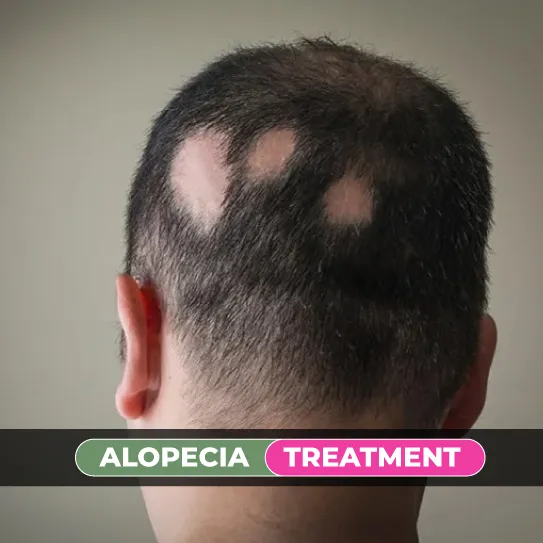
Alopecia Treatment
Alopecia Treatments at Dot ClinicsStop your struggle with Alopecia- severe Hair loss and baldness as Dot Clinics in Multan is providing advanced alopecia treatments to regain hair growth and confidence. Book a consultation today!
Hair loss is a stressful experience affecting self-confidence and the overall personality of a person. Alopecia is a hair disease in which patients observe hair loss,small patches on the scalp and sometimes complete baldness. Alopecia can be genetic, hormonal, or stimulated by environmental factors. At Dot Clinics Multan, we offer advanced alopecia treatments customized to patients desired requirements. Our certified Hair Specialists use the latest procedure, including PRP, Exosome Therapy, and Hair Transplants to restore natural hair growth with maximum effective results.
Alopecia Details

Types of Alopecia
- Genetics or Family history of hair loss.
- Hormonal Imbalance.
- Autoimmune Disorders.
- Poor mental Health.
- Imbalance Diet.
- Medical Disorders like cancer or Tumor.
- Medications.
Clinical Treatments to Treat Alopecia
Some people see small improvements with home remedies. They work best when the condition is in its early stage, like alopecia areata. For more severe types, like alopecia totalis or alopecia universalis, use the right medicines or clinical treatments.
- PRP Therapy: Uses platelet-rich plasma to stimulate hair follicles.
- Exosome Therapy: Uses exosomes with powerful growth factors to promote hair growth.
- Hair Transplant: Involves follicle grafting for permanent and natural looking results.
- Topical & Oral Medications: Minoxidil, finasteride, and supplements may be prescribed.
Home Remedies to Treat Alopecia
You can try home remedies for alopecia first. Save medicines or clinical treatments for later.
- Honey & Lemon: Honey and lemon are great for your scalp. They have antibacterial and anti-inflammatory properties. They help clean your scalp and get rid of dirt and bacteria that might be blocking hair follicles.
- Mix honey with a few drops of lemon and apply it to your scalp.
- After leaving it on for a while, wash it off with shampoo.
- Onions: Onions do more than add flavor to your food. They’re full of sulfur, which helps remove toxins from your body and improve blood circulation.
- They can also help fight autoimmune diseases.
- To use them, cut up an onion, squeeze out the juice, and rub it onto your scalp.
- Oats: Oats pack nutrients like zinc, fiber, iron, and fatty acids.
- They also contain proteins that are good for your hair.
- Eating oats can help promote hair growth, so try adding them to your diet for faster results.
Cost of Alopecia Hair Fall Treatment
The cost of alopecia treatment depends on what treatment you choose. For PRP (Platelet-Rich Plasma) treatment, one session costs about Rs. 8000. For Exosomes, one session may cost 45,000 or plus. If you need more than one session, or if you need other treatments, the price may be higher.
Everyone needs different treatment. We will give you a better idea of how much alopecia treatment will cost in Pakistan.
Get the Best Alopecia Treatment for Men & Women. Schedule Your Appointment Now!
ALOPECIA FAQ's
A consultation with our specialist will help determine the best treatment based on your hair loss type and medical history.
PRP involves minor discomfort, similar to a small injection, but numbing agents are used to minimize pain.
Most patients require 3-6 sessions, spaced a month apart, for noticeable hair regrowth.
Absolutely! Our treatments are suitable for both men and women experiencing hair thinning or bald patches.
